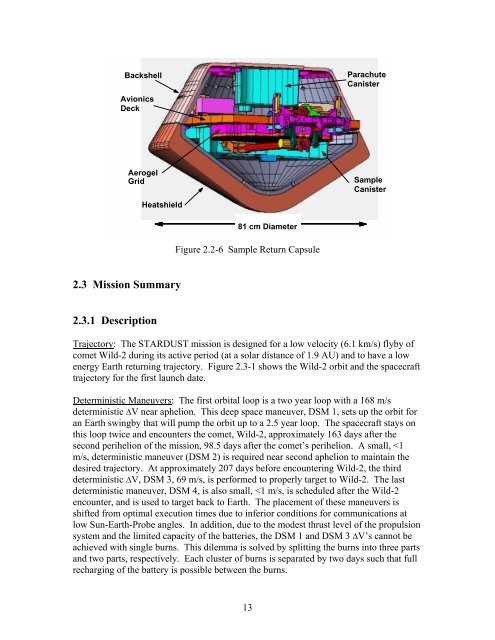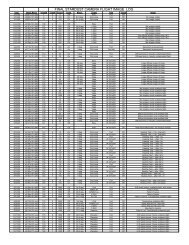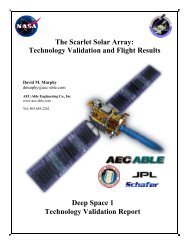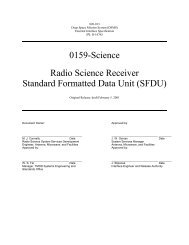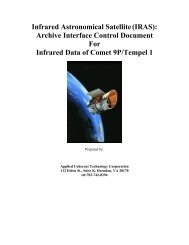- Page 1 and 2: STARDUST MISSION PLAN February 1, 1
- Page 4 and 5: STARDUST MISSION PLAN Edward A. Hir
- Page 7 and 8: Table of Contents Table of Contents
- Page 9 and 10: 10.1.1 Spacecraft Attitude History
- Page 11 and 12: Figure 6.2-1.a Wild-2 Encounter Com
- Page 13 and 14: Table 10.1-3 Spacecraft Attitude Pr
- Page 15 and 16: kg km L L/O Kilogram Kilometer Laun
- Page 17 and 18: Change Log Change Letter Date Affec
- Page 19 and 20: 1.0 Introduction 1.1 Purpose The pu
- Page 21 and 22: 2.0 Mission Overview 2.1 Mission Ob
- Page 23 and 24: Fairing STARDUST Second Stage Star3
- Page 25 and 26: propulsive maneuvers. To avoid pote
- Page 27 and 28: The STARDUST camera is necessary to
- Page 29: of-view is smaller, as described in
- Page 33 and 34: Earth Gravity Assist 01/15/01 Earth
- Page 35 and 36: Cruise 2 (Earth-Wild-2) ISP Collect
- Page 37 and 38: 2.3.2 Launch Period Strategy 2.3.2.
- Page 39 and 40: Table 2.3-2 Baseline Mission Parame
- Page 41 and 42: Table 2.3-2 Baseline Mission Parame
- Page 43 and 44: *B plane angle (deg) -41.051 -40.96
- Page 45 and 46: 2.3.2.2 ∆V Budget The total ∆V
- Page 47 and 48: Accumulation of Radiation with Time
- Page 49: Table 2.3-4 STARDUST Alternate-2 Mi
- Page 52 and 53: calculations will require more deta
- Page 54 and 55: 10 17 10 16 10 15 10 14 10 13 Fluen
- Page 56 and 57: 8 10 flare, no shielding 6 10 4 10
- Page 58 and 59: The orbit of comet Wild-2 was drast
- Page 60 and 61: • Dust density = Nucleus density
- Page 62 and 63: 2.4.4 Interstellar Dust Science Pla
- Page 64 and 65: Launch Initial Acquisition TCM-1 Ac
- Page 66 and 67: Stage II ignition t=277.5 s h=66.4
- Page 68 and 69: Special ‘coming-off-theperiscope
- Page 70 and 71: phases are very similar to the stan
- Page 72 and 73: presented in tables contained in Ap
- Page 74 and 75: Figure 4.2-4.b. Beta Meteoriod Impa
- Page 76 and 77: 180 Off-SEP & ORBIT normal angle (d
- Page 78 and 79: 2/6 launch Events Attitude 74 days
- Page 80 and 81:
yaw, while continuing to meet solar
- Page 82 and 83:
Time Image Description images pixel
- Page 84 and 85:
(EGA-60d to +30d) TCM 4 (EGA-60 d)
- Page 86 and 87:
6.0 Wild-2 Encounter Phase (E-100 t
- Page 88 and 89:
the installation of the HGA. The su
- Page 90 and 91:
Date Sept-03 Oct-03 Nov-03 Dec-03 J
- Page 92 and 93:
Coma images will be acquired primar
- Page 94 and 95:
mirror via a simple one dimension t
- Page 96 and 97:
The cross track error corresponds t
- Page 98 and 99:
14 12 10 24 km 3 sigma distance 1 s
- Page 100 and 101:
All 34-m HEF except selective 70-m
- Page 102 and 103:
SRC Entry / Descent Atmospheric Ent
- Page 104 and 105:
Two TCM’s are planned within this
- Page 106 and 107:
It is important to note that, other
- Page 108 and 109:
8.0 Planetary Protection The object
- Page 110 and 111:
Earth-Probe Range Sun-Earth-Probe A
- Page 112 and 113:
9.1 Mission Data Set (cont) 14.00 E
- Page 114 and 115:
14.00 MOON-PROBE RANGE Launch Phase
- Page 116 and 117:
180.00 SUN-EARTH-PROBE ANGLE EGA Ph
- Page 118 and 119:
180.00 SUN-PROBE-MOON ANGLE EGA Pha
- Page 120 and 121:
180.00 SUN- WILD-2 -PROBE ANGLE Enc
- Page 122 and 123:
Cone & Clock Angles of Wild-2 Cone
- Page 124 and 125:
180 Cone & Clock Angles of Sun 180
- Page 126 and 127:
9.4 Wild-2 Encounter Data Set (cont
- Page 128 and 129:
16.00 MOON-PROBE RANGE Return Phase
- Page 130 and 131:
10.0 Appendix B: Unbalanced Attitud
- Page 132 and 133:
spacecraft attitude when the spacec
- Page 134 and 135:
Time From Launch Off-sun Angle (deg
- Page 136 and 137:
Acceleration (1E-11 km/s/s) 12 10 8
- Page 138 and 139:
+z, yaw +y, pitch +x, roll Figure 1
- Page 140 and 141:
** vectors evaluated at the time of
- Page 142 and 143:
Rgt Ascen (deg) [eme'2000] 360 300
- Page 144 and 145:
Table 10.2-6 Communications Schedul
- Page 146 and 147:
Table 10.2-6 Communications Schedul
- Page 148 and 149:
031228 19180 0 031229 19180 0 03123
- Page 150 and 151:
TRAJECTORY CORRECTION MANEUVERS EVE
- Page 152 and 153:
2453509.10737773 50518. 143437. 229
- Page 154 and 155:
50204. 3437. 2189.12 outb SEP = 3 d
- Page 156 and 157:
Table 12-1 ISP #1 Collection Period
- Page 158 and 159:
Table 12-2 ISP #2 Collection Period
- Page 160 and 161:
Table 12-4 ISP #2 Spacecraft Attitu
- Page 162 and 163:
Table 12-5 CIDA #1 Collection Perio
- Page 164 and 165:
Table 12-6 CIDA #2 Collection Perio
- Page 166 and 167:
908.000 41.659 20.000 9.272 175.100
- Page 168 and 169:
Table 12-8 CIDA #1 Spacecraft Attit
- Page 170 and 171:
Table 12-9 CIDA #2 Spacecraft Attit
- Page 172 and 173:
Table 12-11 CIDA #3 Solar Conjuncti
- Page 174 and 175:
13.0 Appendix E: PRD Traceability M


